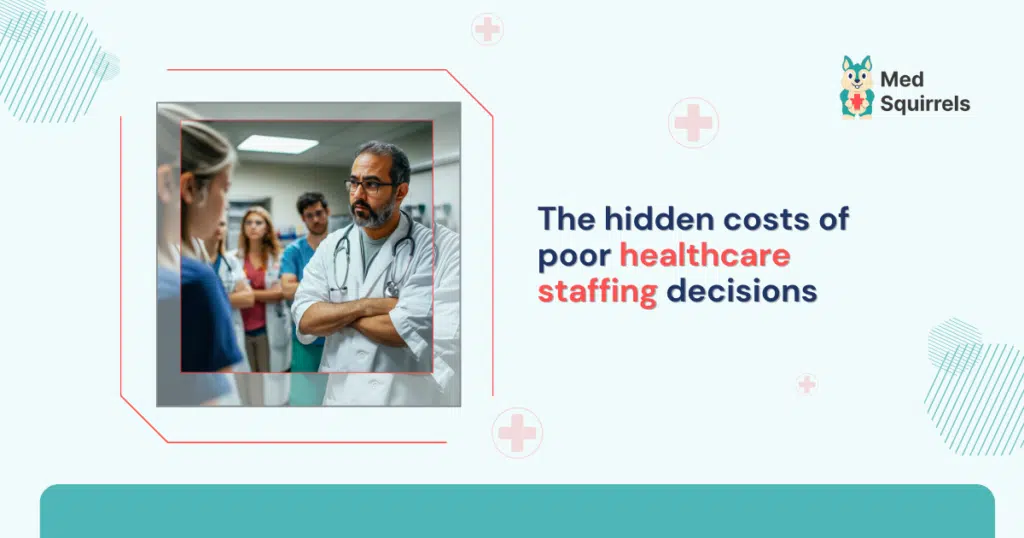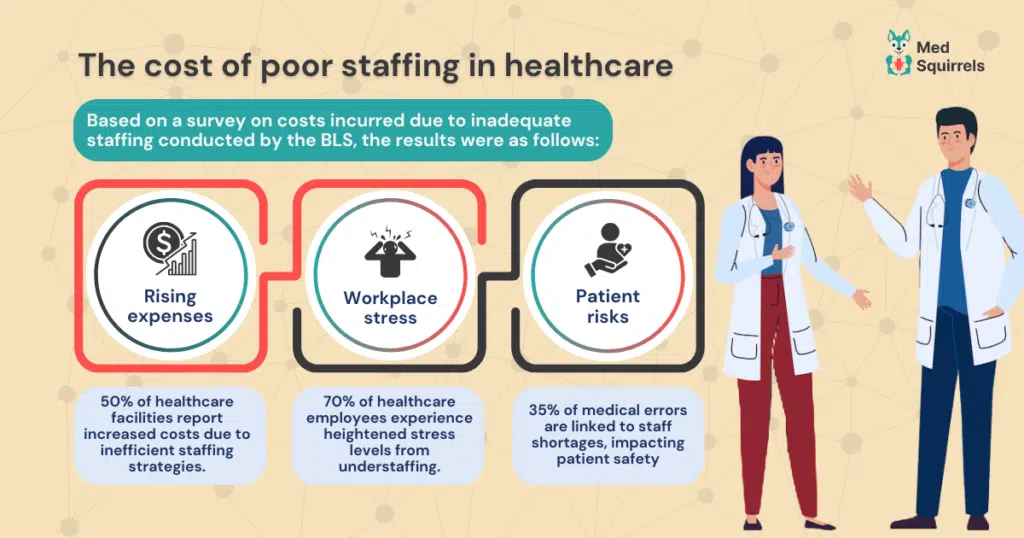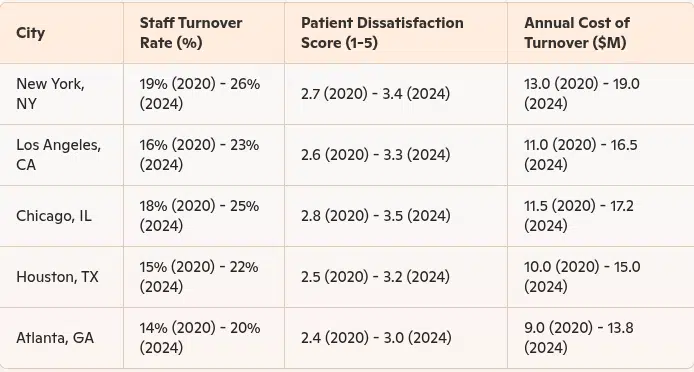The hidden costs of poor healthcare staffing decisions

Adequate staffing is the lifeblood of healthcare, but the hidden costs of poor healthcare staffing can quietly erode even the most robust institutions. These costs—financial burden, increased staff turnover rates, and growing patient dissatisfaction —arise when staffing choices go awry, setting off a chain reaction of problems. What starts as a small error can snowball into a full-blown crisis, affecting every department and level of a healthcare facility.
This blog dives into the underlying causes, ripple effects, and resolutions of healthcare staffing challenges, exposing why addressing these systemic problems is paramount for success. Understanding the consequences of poor healthcare staffing will highlight how it threatens budgets, employee morale, and patient trust. Ultimately, recognizing and tackling these issues proactively can lay the foundation for a stronger, more efficient healthcare system
Understanding healthcare staffing issues
The hidden costs of poor healthcare staffing arise due to ongoing healthcare staffing issues such as shortages and poor resource management. Most hospitals and clinics struggle to maintain an adequate workforce, often lacking enough nurses, physicians, or allied health professionals. Worse, skilled employees may be misallocated, working in roles or shifts that do not match their expertise. High employee turnover in the healthcare industry worsens matters as exhausted workers quit, leaving critical gaps in coverage and increasing operational instability.
These problems do not just create immediate disruptions; they build into long-term challenges such as overwhelming workloads, prolonged patient wait times, and widespread burnout. A facility may scramble through an understaffed shift, but the cumulative stress and fatigue lead to declining productivity and low morale. Recognizing and addressing these healthcare staffing issues is essential to mitigating the broader, long-term impact of poor healthcare staffing on employees and patient care.

The financial impact of poor healthcare staffing
The economic hidden costs of poor healthcare staffing are staggering. Every time a staff member leaves, hospitals and clinics incur significant expenses to recruit and train replacements, driving up staff turnover rates. Hiring is not just about filling positions—it is a costly, time-consuming process that strains already limited resources. Training new hires, covering shifts with overtime, and dealing with lost productivity take a financial toll.
Beyond these direct costs, more profound financial risks—burnout, inefficiency, and declining care quality- impact an organization’s bottom line. An overworked nurse or physician simply cannot perform at peak efficiency, which leads to mistakes, inefficiencies, and even preventable readmissions—all of which drive up costs.
Legal risks add another layer of financial pressure. Understaffing can lead to compliance violations, hefty fines, or even lawsuits. One mistake caused by the impact of poor healthcare staffing can cost thousands—or more—in settlements. The financial burden of these staffing missteps underscores the need for proactive workforce planning to ensure healthcare facilities remain stable and financially sustainable.
Effect on employee retention and workplace morale
The effect of poor healthcare staffing on employees is profound. When there are not enough workers, the remaining staff must shoulder the extra workload, leaving them overwhelmed and frustrated. This constant strain accelerates burnout, leading to even higher employee turnover in the healthcare industry. It is a brutal, self-perpetuating cycle—short-staffing leads to dissatisfaction, dissatisfied employees quit, and their departure exacerbates staff turnover rates.
This is not just a numbers issue—it is a human issue. A nurse juggling too many patients may miss a crucial detail—not due to incompetence, but sheer exhaustion. A physician forced to work excessive shifts may begin to dread their job, leading to emotional detachment from patient care. To break this damaging cycle, healthcare organizations must prioritize employee well-being by implementing fair compensation structures, mental health resources, and balanced scheduling practices. These efforts help minimize the hidden costs of poor healthcare staffing while boosting morale and fostering a more sustainable work environment.
The effect of patient dissatisfaction on healthcare outcomes and quality
Patients bear the brunt of the hidden costs of poor healthcare staffing. When facilities are understaffed, wait times increase, appointments feel rushed, and medical errors become more frequent—leading to greater patient dissatisfaction. A packed emergency room can damage patient trust, while overworked medical staff are more prone to mistakes, harming the quality of care.
These issues have long-term repercussions. Poor patient experiences lead to negative reviews, which hurt a facility’s reputation. Patient dissatisfaction is not just an inconvenience; it can threaten the future of a healthcare facility. Ensuring proper staffing levels enhances care quality, keeping patients satisfied and loyal.
Implications and consequences of long-term healthcare facilities
The hidden costs of poor healthcare staffing create lasting challenges. Budget-draining hiring cycles, including recruitment, overtime pay, and salary increases for overworked employees, become a financial strain. Patient dissatisfaction leads to lower ratings, affecting accreditation and reimbursement. Even well-established facilities can decline if healthcare staffing issues persist.
Operational efficiency also suffers. Frequent employee turnover in the healthcare industry disrupts workflows, forcing teams to train new hires continuously. This results in lower-quality care, rising expenses, and decreased employee morale. Without effective staffing solutions, these problems can push healthcare facilities toward instability.
Rising costs of poor healthcare staffing across major U.S. cities (2020-2024)

Source: www.aha.org/costsofcaring
Strategies to overcome healthcare staffing issues
Proactive solutions exist to minimize the hidden costs of poor healthcare staffing. Strategic workforce planning ensures staffing levels align with demand, reducing employee turnover in the healthcare sector. Imagine having enough nurses before a seasonal patient surge—instead of scrambling at the last minute. Data analytics enhances this process by precisely predicting workforce needs and turning healthcare staffing challenges into manageable solutions.
Prioritizing staff well-being is equally critical. Career development programs, ongoing training, and structured support systems help keep employees engaged. Fair scheduling, mental health initiatives, and competitive pay reduce staff turnover rates, ensuring healthcare workers feel valued and stay committed to their roles. These measures transform staffing from a liability into a competitive advantage.
Build your sustainable healthcare workforce with MedSquirrels
The consequences of poor healthcare staffing practices extend beyond financial concerns, affecting employee well-being, patient care quality, and healthcare facility stability. Persistent staffing issues and high turnover rates create inefficiencies and erode patient trust, impacting operations and reputation.
Traditional staffing models often have high costs, lack transparency, and unreliable workforce management. Hidden fees, excessive agency charges, and inefficient hiring processes lead to financial strain and operational disruptions.
MedSquirrels helps healthcare facilities tackle these challenges with tailored workforce solutions. Our approach reduces turnover, improves efficiency, and enhances patient care through data-driven workforce planning, optimizing staffing while mitigating risks. Learn more about how we streamline healthcare staffing with our proven methodology.
Three reasons to choose MedSquirrels to staff your facility
- Flat-fee pricing model without markups: Unlike traditional staffing agencies that impose high markups, MedSquirrels offers a straightforward, flat-fee pricing model that ensures cost-effectiveness and budget predictability.
- Three unique plans based on your hiring needs:
- Orange Plan: A comprehensive solution covering recruitment and payroll for contract allied healthcare professionals.
- Purple Plan: A payroll, benefits, and compliance management service for contract hires sourced by healthcare facilities.
- Blue Plan: A recruitment-only service providing a cost-effective alternative to traditional agencies. Click here to explore our staffing plans.
- Better than traditional staffing in every aspect: Unlike traditional Managed Service Providers (MSPs) that often include hidden costs and rigid contracts, MedSquirrels provides a flexible and transparent alternative that maximizes efficiency and minimizes unnecessary expenses. Click to compare our model with MSPs.
Adequate staffing builds a strong, reliable team dedicated to patient well-being, reducing burnout and improving workplace satisfaction. Investing in the right workforce solutions today ensures a more sustainable future for healthcare facilities. Discover how MedSquirrels can help you achieve long-term staffing success. Request a demo!
FAQs:
Why do healthcare staffing issues arise?
Healthcare staffing issues stem from shortages of nurses, physicians, and allied health professionals, poor resource management, and misallocating skilled employees to unsuitable roles or shifts.
What are the Hidden Costs of Poor Healthcare Staffing?
The Hidden Costs of Poor Healthcare Staffing include financial burdens like recruitment and training expenses, increased staff turnover rates, and growing patient dissatisfaction due to compromised care quality.
What is the financial impact of poor healthcare staffing?
The financial impact includes high costs from hiring and training replacements, overtime pay, lost productivity, and potential legal risks like fines or lawsuits due to understaffing-related errors.
How can MedSquirrels help reduce the Hidden Costs of Poor Healthcare Staffing?
MedSquirrels offers tailored workforce solutions that optimize staffing levels, lower recruitment costs, and improve efficiency, directly addressing the financial burden of poor healthcare staffing
Can MedSquirrels enhance patient satisfaction despite staffing challenges?
Yes, MedSquirrels ensures proper staffing levels to minimize wait times and errors, enhance care quality, and reduce patient dissatisfaction with a reliable workforce.
